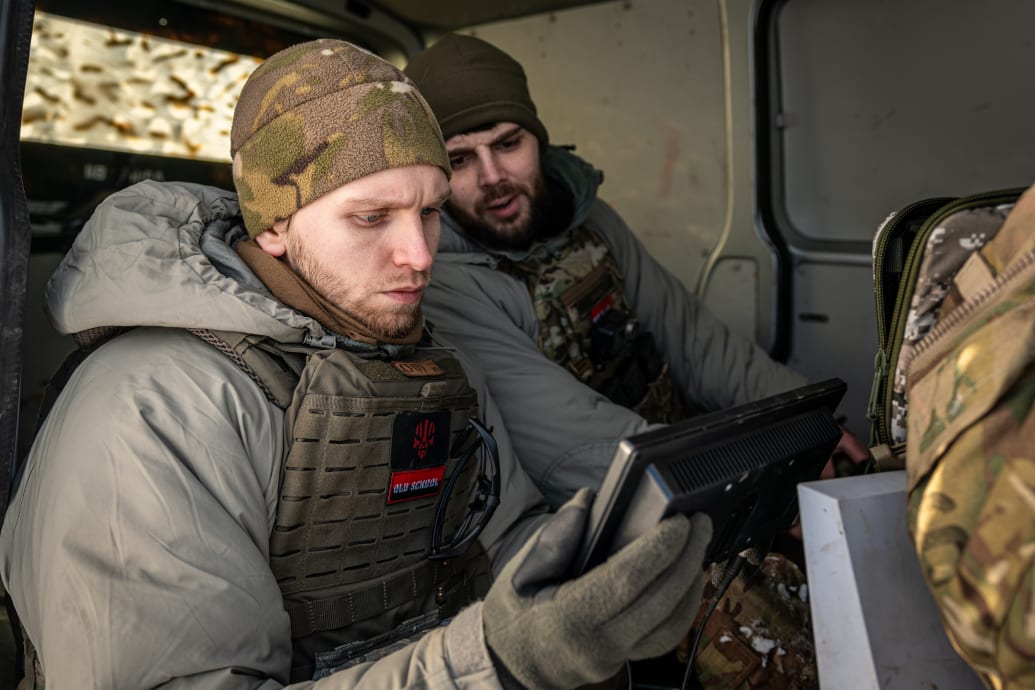Israel’s use of artificial intelligence to help its forces select targets for air strikes worries A.I. skeptics and human-rights advocates. A targeting A.I. is only as smart as the people who trained it—and those people are prone to dropping bombs in the wrong places, these experts warned. All that is to say, Israel’s A.I. air strikes risk further endangering civilians in Gaza.
A thousand miles away, however, A.I. could help outnumbered Ukrainian troops hold off the invading Russian army. Self-teaching targeting algorithms, installed in nimble quadcopter drones, could solve a serious problem that has plagued Ukraine’s drone operations. Stung by the Ukrainians’ successful deployment of small explosives-laden drones, the Russians have begun installing radio-jamming electronic-warfare gear—“E.W.” in military parlance—on vehicles all along the 600-mile front of Russia’s 22-month wider war on Ukraine.
These jammers can block the signals that connect Ukraine’s numerous first-person view (FPV) drones to their operators, hunkering down miles away, seeing what the drone sees through their virtual-reality headsets. When an FPV drone loses its signal, it might fly off course—and miss whatever tank, artillery piece, or bunker the operator was aiming it at.
An FPV drone works by flying directly into its target and exploding, like a tiny missile—but there’s a human controller in the loop the whole time. A drone’s connection to its operator “is a major vulnerability point, since it can be affected by E.W.,” Samuel Bendett, a senior non-resident associate with the Center for Strategic and International Studies in Washington, D.C., told The Daily Beast.
Ukrainian soldiers prepare a long range drone near the Bakhmut frontline, in Donetsk Oblast, Ukraine on January 12, 2024. Drone warfare has become increasingly important as the war entered into a stalemate and both sides are heavily fortified.
Ignacio Marin/Anadolu via Getty Images
Keenly aware they have a jamming problem, Ukraine’s drone developers are working on an A.I. solution: an algorithm that quickly learns to recognize a drone’s target. That way, if the jamming gets too intense and the drone loses its command signal, the A.I. can take over control from the human operator—and steer the drone to a successful strike.
At least one Ukrainian company, Twist Robotics, has already tested a drone-targeting algorithm. “After the target is locked, the drone is guided by this system,” Rostyslav Olenchyn, a Twist Robotics co-founder, told The Washington Post.
If Israel’s air-strike algorithm is the dark side of military A.I., Ukraine’s drone-steering A.I. is the light side. The Israeli A.I. risks taking innocent lives; in helping Ukrainian forces defend their homes from Vladimir Putin’s forces, the Ukrainian A.I. could save innocent lives. It’s a reminder that the A.I. revolution can be complicated—especially in warfare.
Ukraine’s drone algorithm wasn’t always necessary. Early in Russia’s war of aggression, Ukraine had a big advantage over Russians when it came to robotics, thanks in large part to Ukraine’s strong tech sector and its close ties to high-tech industry in the United States and the rest of Europe.
The Ukrainians had more and better drones than Russia, and used them in smarter ways. The Ukrainian air force’s missile-armed TB-2 drones—its answer to the U.S. Air Force’s Predator and Reaper drones—wreaked havoc on Russian formations rolling toward Kyiv in the wider war’s early weeks.
More recently, as the war has settled into a “positional” phase, where both sides are dug in and neither can advance very far, small FPV drones—each weighing just a couple of pounds and ranging a few miles while carrying a pound or so of explosives—have become the weapon of choice for Ukrainian brigades. The Ukrainians deploy hundreds, sometimes thousands, of the drones every day; Ukrainian president Volodymyr Zelensky vowed to build another million FPV drones next year.
The Russians deploy FPV drones, too—and in greater numbers in some sectors of the front. But the tiny flying robots are more important to the Ukrainians than the Russians because the Ukrainians count on them to make up for shortages of heavy artillery. The Russians, on the other hand, usually have artillery to spare.
In Ukrainian hands, FPV drones are deadly weapons. Robert Brovdi, commander of a Ukrainian drone group called the Birds of Magyar that defends Ukrainian positions in Kherson Oblast, claimed his group has struck 450 Russian vehicles since mid-October—and totally destroyed 153 of them.
Ukraine’s new drones-first strategy didn’t go unnoticed, or unanswered. As the number of Ukrainian FPV drones spiked earlier this year, Russia scoured its arsenal for anything that might help it defeat the drones. It settled on the RP-377, a backpack-mounted radio-jammer that broadcasts hundreds of watts of noise along the most popular frequencies for radio communications.
The Russians developed the RP-377 a few years ago to protect troops from the radio-triggered roadside bombs that are popular with militants in places such as Syria, where Russia has deployed forces to bolster Syrian strongman Bashar Al Assad. In recent months, RP-377s have appeared on Russian tanks, armored personnel carriers, and even artillery all along the front line in Ukraine.

Ukrainian soldiers monitor the signal of a long range drone flying near the Bakhmut frontline, in Donetsk Oblast, Ukraine on January 12, 2024.
Ignacio Marin/Anadolu via Getty Images
At $10,000 or so per copy, the jammers aren’t terribly expensive by military standards. However, the RP-377s aren’t quite standard equipment for Russian vehicles in Ukraine, but they’re more common by the day. And they seem to work as often as they don’t. Generating hundreds of watts of power, they can create a drone-proof bubble of safety around a vehicle.
“I saw the spectrograms,” Ukrainian drone expert Serhii Beskrestnov wrote in a Telegram post detailing his analysis of an RP-377. “The interference is very high quality.” Fortunately for the Ukrainians, the RP-377 has a short range, according to Beskrestnov—possibly just tens of feet.
The most skilled Ukrainian drone-operators have been able to fly their explosive robots right through the jamming, by making sure their drones are aimed precisely at their targets as the drones enter the bubble of radio-jamming. That way, a drone is already barreling toward a successful strike as it loses its radio link and the operator can no longer correct its course.
But better jammers than the RP-377 are beginning to appear on Russian vehicles, including the new Volnorez, which reportedly works out to a distance of half a mile. That’s far enough that, if it jams an approaching FPV drone, the vehicle wearing the Volnorez should have time to dodge the now-uncontrolled incoming drone.
Operator skill alone probably won’t be enough for Ukrainian forces to maintain their drone edge as newer and better Russian jammers proliferate. But operator skill with a little A.I. assistance just might suffice.
Here’s how it could work: As an operator steers their FPV drone toward a target, an algorithm peering through the drone’s forward-looking video camera would quickly teach itself to recognize the target by size, shape, color—even by infrared heat signature.
That way, if the drone runs into jamming and loses its radio link to its operator, the A.I. could continue steering the drone toward the same target.
“The biggest risk with A.I. is the hype cycle, where advocates of A.I. overstate what the technology can do, ignoring its limitations,” Carlo Kopp, an analyst at the Air Power Australia think-tank who has decades of experience studying surveillance and targeting problems, told The Daily Beast. “This is a historical pattern seen many times when a new technology is introduced.”
Ukrainian developers aren’t asking their algorithm to monitor entire cities and determine which of millions of people might be enemy fighters, like the Israelis reportedly are asking of their own A.I..
No, Ukraine’s developers have tasked their A.I. with a much narrower task: Take a target that a human being has already chosen, and remember what it looks like. This reflects a central tenet of Ukrainian drone philosophy, Beskrestnov said in a recent video. “Our military is not ready to completely give artificial intelligence control over firing weapons.”
If there’s a downside, it’s the potential cost. Ukraine has embraced FPV drones because FPV drones are cheap. If every new drone the Ukrainians import or build must also go to some workshop to have A.I.-assisted controls installed, the cost could go way up.
But given a choice between paying more for their drones, or watching their drones become obsolete, it’s obvious what the Ukrainians would choose. It’s equally obvious that, given the choice between joining forces with an A.I. or surrendering an important battlefield advantage to the Russians, the Ukrainians would choose the A.I.
 Unmanned Aerial Vehicle The latest drone news
Unmanned Aerial Vehicle The latest drone news




